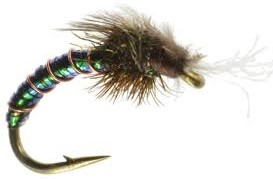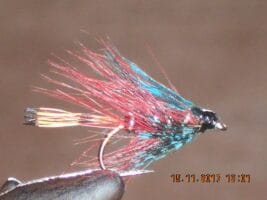Your cart is currently empty!
Flash Midge Pupa Fly
The Flash Midge Pupa represents the perfect combination of traditional design and modern innovation. Its carefully selected materials and precise construction ensure consistent performance across various fishing conditions.
Description
Historical Significance and Pattern Evolution
The Flash Midge Pupa fly represents a modern refinement of traditional midge pupa patterns, specifically designed to imitate the emerging stage of midge larvae. This innovative pattern incorporates subtle flash materials to simulate the gas bubble that forms during the natural insect’s emergence process. Originally developed for technical tailwater fishing, this pattern has gained widespread popularity for its effectiveness during mid-day midge emergences when trout are actively feeding in the upper water column.
Premium Materials and Construction Details
Essential Materials List:
- Hook: Fine wire scud/pupa hook (sizes 16-22)
- Thread: Black or olive 8/0
- Body: Thread base with flash dubbing
- Rib: Fine silver or pearl wire
- Wing Case: Black synthetic or flash material
- Thorax: Darker dubbing
- Flash: Pearl or crystal flash
- Head: Thread with clear finish
- Optional: Small glass bead
- Optional: CDC enhancement
Material Selection Considerations:
- Hook size matches natural insects
- Thread strength crucial for durability
- Body materials create translucence
- Rib adds segmentation
- Wing case provides contrast
- Thorax creates proper profile
- Flash amount affects visibility
- Head finish protects materials
- Material preparation affects profile
- Storage conditions preserve materials
Detailed Tying Instructions
Preparation Steps:
- Select appropriate hook size
- Choose quality materials
- Prepare flash materials
- Select thread color
- Organize workspace
- Check tools
- Plan proportions
- Review pattern
- Test thread strength
- Prepare dubbing
Step-by-Step Tying Sequence:
- Start thread behind eye
- Create uniform thread base
- Tie in rib wire
- Form tapered body
- Add flash elements
- Counter-rib wire
- Build thorax
- Add wing case
- Form neat head
- Whip finish
- Apply head cement
- Check proportions
Advanced Fishing Techniques
Presentation Methods:
- Dry-dropper rig
- Deep nymphing
- Suspension fishing
- Film presentation
- Indicator nymphing
- Short-line nymphing
- Current seam fishing
- Structure approaches
- Pattern combinations
- Dead drift tactics
Water Reading Skills:
- Identify feeding lanes
- Recognize current breaks
- Spot rising fish
- Detect subsurface activity
- Read water clarity
- Locate prime lies
- Find transition zones
- Identify temperature breaks
- Track fish movement
- Monitor insect activity
Seasonal Strategies
Winter Tactics:
- Focus on midday hatches
- Target slow water
- Match natural movement
- Adjust depth
- Monitor temperatures
- Watch for activity
- Follow fish movement
- Time presentations
- Adapt to conditions
- Match natural drift
Spring/Fall Applications:
- Early morning fishing
- Late evening sessions
- Target productive runs
- Focus on seams
- Match daily patterns
- Observe feeding windows
- Adjust to conditions
- Monitor water levels
- Watch temperatures
- Time presentations
Summer Approaches:
- Target early mornings
- Focus on deep runs
- Adjust presentation depth
- Watch water conditions
- Monitor temperatures
- Follow movement patterns
- Adapt to weather
- Time efforts effectively
- Match natural drift
- Adjust techniques
Technical Rigging Considerations
Leader Construction:
- Long, fine tippets
- Quality fluorocarbon
- Proper diameter selection
- Breaking strength considerations
- Length adjustments
- Material choices
- Knot selection
- Visibility factors
- Sink rate control
- Setup variations
Terminal Tackle:
- Direct connection methods
- Dropper setups
- Leader construction
- Line control
- Strike detection
- Depth adjustment
- Pattern spacing
- Drift control
- Presentation angles
- Setup modifications
Habitat-Specific Tactics
Water Types:
- Tailwaters
- Spring creeks
- Freestone streams
- Still waters
- Mixed waters
- Clear streams
- Pocket water
- Riffles
- Pools
- Runs
Specific Locations:
- Feeding lanes
- Current seams
- Structure edges
- Film zones
- Mid-column
- Transitions
- Drop-offs
- Shallow flats
- Deep runs
- Protected areas
Advanced Presentation Methods
Traditional Techniques:
- Dead drift
- Swing presentation
- Strip retrieve
- Lift and drop
- Cross-current drift
- Deep presentation
- Film presentation
- Structure approach
- Bank presentation
- Depth control
Modern Adaptations:
- Euro nymphing
- Indicator methods
- Multiple fly rigs
- Edge water tactics
- Structure approaches
- Pattern combinations
- Presentation modifications
- Depth control
- Speed variations
- Drift management
Pattern Variations
Size Considerations:
- Match natural insects
- Consider water type
- Adapt to pressure
- Account for clarity
- Follow seasonal trends
- Consider fish size
- Match preferences
- Adapt to conditions
- Consider speed
- Match forage base
Style Variations:
- Traditional thread body
- Glass bead version
- CDC enhanced
- Extra flash
- Minimal flash
- Thorax variations
- Wing case options
- Color variations
- Size variations
- Seasonal patterns
The Flash Midge Pupa represents the perfect combination of traditional design and modern innovation. Its carefully selected materials and precise construction ensure consistent performance across various fishing conditions. Whether targeting selective trout during specific hatches or searching for opportunistic feeders, this pattern provides the perfect tool for successful subsurface fishing throughout the season.
Additional information
| Hook size | 16, 18, 20, 22 |
|---|---|
| Hook type | Barbed Hooks, Barbless Hooks |







